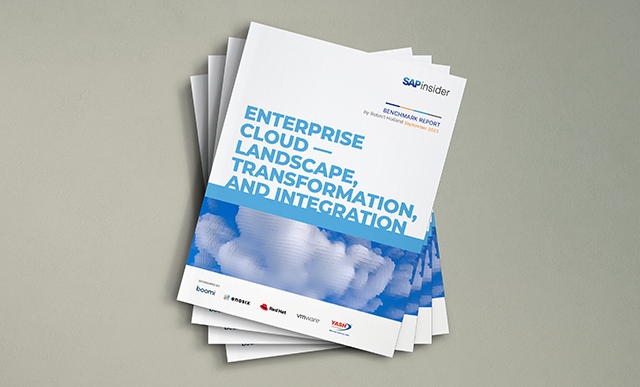In mid-2019, SAPinsider reported that while the vast majority of the SAP community is somewhere along the journey of transitioning its enterprise resource planning to the cloud, many companies are still at an early stage. However, recent moves at SAP signal a strong interest in catalyzing that transition and, in turn, it has some SAP customers thinking about accelerating their move to the cloud.
Consider what happened when Bill McDermott stepped down in October 2019 after nine years as SAP’s CEO. During his tenure, McDermott led the development and rollout of SAP S/4HANA, powered by the SAP HANA inmemory database, as SAP’s flagship ERP suite as well as over $27 billion in cloud acquisitions. Along the way, it became clear that SAP’s future lies in its installed base transitioning to SAP S/4HANA and the cloud, and its ability to integrate experience throughout the enterprise, making Jennifer Morgan, president of SAP’s cloud business group, who was announced as co-CEO with COO Christian Klein, a logical choice.
Only a week after naming Morgan and Klein as co-CEOs, SAP then announced a strategic partnership with Microsoft that emphasizes Microsoft Azure as the key cloud platform for supporting SAP S/4HANA — a move that is directly related to helping SAP customers boost their transition to the cloud. “We’ve listened to our customers who have asked us to help them define and accelerate their journey to SAP S/4HANA in the public cloud,” Morgan said while announcing the partnership. “Many of our enterprise customers have chosen Azure. In response, SAP and Microsoft have established a partnership to move on-premise SAP ERP and SAP S/4HANA customers to the cloud through industry-specific best practices, our joint reference architecture, and SAP cloud delivered services on Azure. This partnership will accelerate and simplify customer migrations to SAP S/4HANA on Azure.”
While the Microsoft partnership and the ascension of SAP’s top cloud champion to co-CEO are the headline-grabbing signals, they are far from the only indicators that SAP is seeking to accelerate its customers’ journey to the cloud. This means that SAP customers have pressing decisions to make about their transition to the cloud as they look at the 2020 roadmap for their businesses and must consider tackling migration challenges sooner rather than later.
Using insights gleaned from the research conducted for SAPinsider’s “
Enterprise Cloud Migration: State of the Market” benchmark report, this article outlines seven tips that will help you succeed as you evaluate your strategy for the cloud.
1. Consider Cloud First
The concept of considering cloud first doesn’t mean always choosing cloud regardless of the circumstances. However, the truth is that SAP is ramping up its development, support, and marketing/sales organizations to support a cloud-first strategy. This means that SAP will continue to expand its tools, accelerators, and content to help ease customer deployment to the cloud. The SAP and Microsoft announcement is a first step in this direction — expect more content and offerings as SAP collects feedback and experience with SAP S/4HANA on Microsoft Azure projects.
The billions of dollars SAP has invested in acquiring cloud-based business solutions will contribute to the acceleration of customer migrations to cloud solutions from traditional on-premise applications. This is playing out with SAP SuccessFactors and SAP Hybris solutions, for example, as SAP establishes more incentives for customers to move from on-premise human resources (HR) and customer relationship management (CRM) environments to the cloud-based solutions, and starts to siphon off development and investment in the on-premise offerings.
SAPinsider’s
SAP S/4HANA: State of the Market research report (April 2019) shows that the cloud-first mindset is starting to seep into the customer psyche — for example, 60% of SAPinsiders indicate that they plan to deploy SAP S/4HANA within some kind of cloud environment, and as many as 70% of early adopters of SAP S/4HANA have chosen the cloud model (see
Figure 1).
 Figure 1: 70% of SAP S/4HANA adoption “leaders” are using some form of a greenfield implementation
Figure 1: 70% of SAP S/4HANA adoption “leaders” are using some form of a greenfield implementation
When it comes to SAP S/4HANA deployment, SAP is reporting similar trends on a global basis. “We’re seeing growth on both software-as-a-service (SaaS) and infrastructure-as-a-service (IaaS) models,” says Sven Denecken, Senior Vice President of Product Management, Co-Innovation, SAP S/4HANA at SAP SE. “Net-new customers tend to deploy on the cloud and as SaaS, while many of our largest enterprise customers are staying in a hybrid mix of on premise and SaaS, leveraging IaaS as standard. Overall our compound annual growth rate on cloud is higher and we see significant differences between regions. Some of our largest and fastest cloud growth is coming from China.”
2. Ramp Up Your In-House Cloud Expertise
SAPinsider’s “Enterprise Cloud Migration: State of the Market” report (July 2019) shows that while a majority (92%) of SAPinsiders have deployed a cloud solution within their enterprise, nearly half (46%) say their cloud initiatives have not met their expectations or that it is still too early in their journey to tell.
According to the research, lack of skills and inexperience is the biggest reason for some of the early missteps organizations are experiencing with the cloud. Those companies still struggling to gain a return on investment (ROI) from the cloud rated their organizational strength in cloud skills at just 3.17 out of 5 on average. Overall, SAPinsiders acknowledge that there is plenty of room to improve their cloud skills, as they rate themselves at 3.29 out of 5 on average.
Experts and consultants also report that there are misconceptions about what skills and staff companies need to retain to effectively support the cloud. “Many organizations mistakenly assume they can reduce their IT department to a minimum when they go to the cloud,” says Winni Hessel, Partner, Enowa. “The fact that you don’t’ have a box to support anymore doesn’t mean you don’t need a technical resource. There are important integration aspects about cloud that you still have to understand and manage.”
SAPinsiders report being most confident in security, compliance, and vendor management, and least assured in user training, overall cloud skills, and testing cloud applications and projects. When it comes to training, the fundamentals are key. Know the options for running SAP S/4HANA in the cloud. SAP offers a few possibilities for single tenant and multitenant scenarios. Moving forward, its public cloud options will focus on multi-tenant scenarios.
Organizations that want to retain control over their landscape and enable more customization while still gaining some of the benefits of the cloud can run their on-premise license in either a managed or hosted environment, or can deploy on a hyperscale environment such as Microsoft Azure, Amazon Web Services (AWS), and Google Cloud Platform. It is essential to understand how resources are allocated and managed in these specific environments.
3. Prioritize and Expand Integration Knowledge
SAPinsider research invariably shows that no enterprise is moving 100% to the cloud right away, and many will instead support hybrid environments. For most, “hybrid” means not just a mix of cloud and on-premise landscapes, but also a variety of cloud models, including SaaS, IaaS, and platform-as-a-service (PaaS) models in both public and private flavors.
Organizations’ cloud roadmaps will be determined by the parts of their deployment they want to manage and control, such as their applications, data, runtime, operating system, and middleware. SAPinsider’s “
Enterprise Cloud Migration: State of the Market” report shows a particularly strong trend over the next year toward increasing the use of PaaS options, and an almost 20% rise in PaaS solutions is likely, driven in part by SAP Cloud Platform, which SAP is positioning as a key foundation for its overall integration strategy. This, combined with the overall hybrid trend, will put a larger premium on integration skills and know-how.
In addition, at the recent SAP TechEd events in North America and Europe, SAP announced it will build and release a new semantic integration layer that provides an easier bridge between its enterprise solutions and reduces the need for custom integration. In the meantime, SAP customers will need to sharpen their application programming interface (API) and integration knowledge in the cloud to ensure tight connectivity within and outside their landscapes.
4. Broaden Your Perspective on Partner Management and Selection
SAP customers are used to selecting software, hardware, and service providers for critical implementations, upgrades, and other significant undertakings. While many of these requirements are applicable in the cloud, there are new factors to consider as part of the vendor selection and management process.
Because engaging with a partner means entrusting the availability, performance, and security of critical organizational assets, SAP customers must appropriately define and manage expectations at the onset of the agreement — and must remain vigilant and aware of contingencies as issues arise. It starts with service-level agreements (SLAs), which can be quite complex and should cover:
- The vendor’s backup and recovery processes
- Where the vendor stores data, which is particularly relevant in light of regulations such as the EU’s Global Data Protection Regulation (GDPR)
- How the vendor allocates resources
- What happens if the customer overuses specific resources
- How the vendor’s edge infrastructure works and the impact it has on the customer’s regional footprints
These are just some of the many questions and issues SAP customers must fully understand to ensure that their processes, data, and systems are consistently optimized and protected.
Cloud vendors should also have solid experience in a customer’s industry, the regions in which the organization functions, and at the scale that the business operates. According to the recent enterprise cloud migration research, SAPinsiders look at a wide range of factors in considering cloud providers (see
Figure 2), but price, security, and SLAs top the list of priorities.
 Figure 2: Price (54%) and security (45%) were the top criteria identified for selecting a cloud vendor
Figure 2: Price (54%) and security (45%) were the top criteria identified for selecting a cloud vendor
5. Build Solid Expertise in Cloud Accounting and Cost Management
Many of the experts and companies interviewed for SAPinsider’s “
Enterprise Cloud Migration: State of the Market” report stress the importance of understanding the litany of potential charges and costs that can affect planning and budgeting for cloud-related projects.
This is particularly true for hyperscale environments, where most cloud contracts are based on use of resources — such as systems, memory, disk, and CPU usage — rather than a steady monthly charge based on the number of users. If the usage rate bursts, for some reason, this can drive up cloud costs significantly. SAP customers need to have a fundamental understanding of these potential costs and should estimate both best-case and worst-case scenarios to ensure visibility and enable alerts when approaching
predetermined thresholds.
The other significant component of the cloud cost equation relates to human capital, skills, and consulting. Moving a significant application or workload to the cloud doesn’t mean throwing everything over the wall and forgetting about it. For example, in most cases, deploying SAP S/4HANA in a hyperscale environment still requires working with a partner that knows how to size resources and requirements in specific cloud environments and how to provision resources properly for performance and availability. These resources could be used primarily during the initial deployment, but these skillsets may be required on an ongoing basis as issues and changes arise.
“While there’s a growing appetite to move to the cloud to get rid of hardware and shrink the data center, many enterprise shops underestimate the complexity and the knowledge needed to support their environment in the cloud,” says Don Loden, Managing Director, Protiviti. “Because a lot of companies are still early in the journey, the skills to manage enterprise applications are not necessarily easy to find.”
6. Do Not Underestimate or Underutilize the Cloud for Innovation
One of the misconceptions and misunderstandings about the cloud is that its value is in simplified management and the ability to reduce resources to support basic infrastructure. Early cloud adopters that are having success in the cloud look beyond these areas and are just as focused on using the cloud as a foundation for innovation.
SAPinsider’s cloud migration benchmark report shows that 12% of SAP customers achieved better than expected results with their cloud deployments and nearly half of these “leaders” report that cloud-based innovation is a top priority for their organization. This group sees cloud as a way to deploy new solutions rapidly and as a means to leverage emerging technologies—such as big data analysis, artificial intelligence, and blockchain—without having to build these services on their own.
The cloud offers significant opportunities to tap into collective or community-based innovation in a variety of ways. The more that an organization understands these services and starts experimenting with them, the faster it can integrate these offerings within organizational innovation strategies and processes.
7. Overprepare for Change Management
Change management has become a cliché in project management circles but takes on special significance when it comes to the cloud — it was one of the most frequently mentioned lessons reflected in the SAPinsider cloud migration research. For most companies, the changes that come with cloud projects are felt throughout the organization, from the user all the way to IT and overall support.
SAPinsider’s conversations with early cloud adopters show that education and setting expectations are key components of cloud-based change management initiatives. Change within a cloud project could range from a different user interface to new functionality, a focus on standardized versus non-customized processes, or a new way of applying patches and fixes.
“Most SAP customers are very used to having custom- built applications that they can tailor and fit to their needs,” says Eric Ledu, SAP Principal, SAP Solutions and Innovation, Createch. “It’s very easy to say ‘best practices,’ but when you have to tell people that the way they’re working is wrong, that’s a tough conversation to have. That’s why you have to dedicate some resources to change management.”
Cloud project managers must perform intensive analysis on how new cloud projects and solutions will affect all levels of the organization, including IT, business users, and management, and then follow that analysis with strong communication and educational plans.
Positioned for Success
No matter where you are in the transition to the cloud — whether you are skeptical, deep into the shift, at the early stages, or still compiling research — market conditions are encouraging you to speed the process. This is not necessarily a bad thing, since software is almost universally moving to the cloud, and you need to be prepared. By considering the seven tips outlined here as part of your planning process, you will be well positioned make the right decisions and give your organization its best chance for success.
 Figure 1: 70% of SAP S/4HANA adoption “leaders” are using some form of a greenfield implementation
When it comes to SAP S/4HANA deployment, SAP is reporting similar trends on a global basis. “We’re seeing growth on both software-as-a-service (SaaS) and infrastructure-as-a-service (IaaS) models,” says Sven Denecken, Senior Vice President of Product Management, Co-Innovation, SAP S/4HANA at SAP SE. “Net-new customers tend to deploy on the cloud and as SaaS, while many of our largest enterprise customers are staying in a hybrid mix of on premise and SaaS, leveraging IaaS as standard. Overall our compound annual growth rate on cloud is higher and we see significant differences between regions. Some of our largest and fastest cloud growth is coming from China.”
Figure 1: 70% of SAP S/4HANA adoption “leaders” are using some form of a greenfield implementation
When it comes to SAP S/4HANA deployment, SAP is reporting similar trends on a global basis. “We’re seeing growth on both software-as-a-service (SaaS) and infrastructure-as-a-service (IaaS) models,” says Sven Denecken, Senior Vice President of Product Management, Co-Innovation, SAP S/4HANA at SAP SE. “Net-new customers tend to deploy on the cloud and as SaaS, while many of our largest enterprise customers are staying in a hybrid mix of on premise and SaaS, leveraging IaaS as standard. Overall our compound annual growth rate on cloud is higher and we see significant differences between regions. Some of our largest and fastest cloud growth is coming from China.”
 Figure 2: Price (54%) and security (45%) were the top criteria identified for selecting a cloud vendor
Figure 2: Price (54%) and security (45%) were the top criteria identified for selecting a cloud vendor








